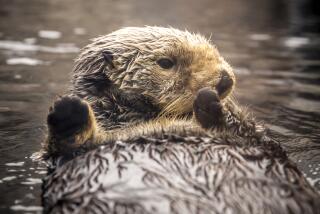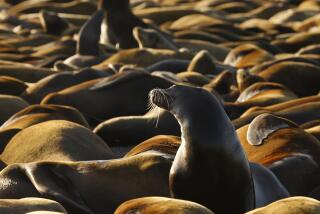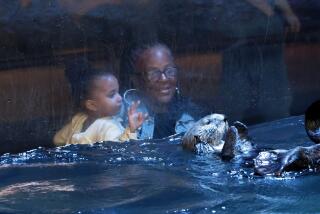Mr. Mom’s Two Babies Hang On
Two baby weedy sea dragons are still alive--but barely--at the Long Beach Aquarium of the Pacific, officials said Monday.
The babies survived a premature birth last week to a male sea dragon known as “Mr. Mom,” whose pregnancy brought international attention to the 2-year-old aquarium. The sea dragon, a relative of the sea horse, is one of five fish groups in which the males incubate eggs.
Mr. Mom, who carried about 80 eggs, died June 6, in his fifth week of pregnancy, about a week before he was expected to give birth. His death prompted the premature hatching of about two dozen eggs. Ten lived a day or so.
The two survivors--about the size of a toothpick--are not eating or swimming. But each is drawing nourishment from a still-attached yolk sac and wriggling around at the bottom of a private tank. They sleep with a night light, just like the aquarium’s adult sea dragons.
“At this point, they look so fragile, and it looks like their chances are still very slim,” said Sandy Trautwein, the aquarium’s curator of fishes and invertebrates. “If they get to the point where they could eat on their own, that would be great progress.”
Trautwein estimated that the babies can live off their yolk sacs for another few days. After that, the staff will feed them live, freshly hatched mysids, tiny shrimp-like crustaceans that are part of a sea dragon’s regular diet.
Even if the babies survive, they would not be put on display for several months, to spare them undue stress, Trautwein said.
She still doesn’t know what went wrong with Mr. Mom but is reviewing every step of his pregnancy.
“It has been such a roller coaster,” she said. “Maybe we can learn from this. I still think it’s a tremendous success, the very fact that [sea dragons] had bred, and he did accept the eggs, and the babies got as far as they did. . . . We did do something special here.” Mr. Mom was the third captive sea dragon in the world to become pregnant. But no babies have survived more than eight weeks.
The sea dragon is a protected species in Australia. Conservationists are working to protect and count the species, whose population is unknown.
More to Read
Sign up for Essential California
The most important California stories and recommendations in your inbox every morning.
You may occasionally receive promotional content from the Los Angeles Times.










